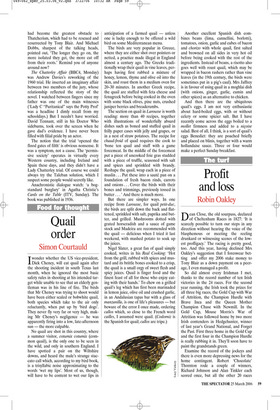Quail order
Simon Courtauld
Iwonder whether the US vice-president, Dick Cheney, will eat quail again after the shooting incident in south Texas last month, when he ignored the most basic safety rules in shooting at his intended target while unable to see that an elderly gentleman was in his line of fire. The birds that Mr Cheney was trying to shoot would have been either scaled or bobwhite quail, both species which take to the air only reluctantly, when put up by ‘bird dogs’. They never fly very far or very high, making Mr Cheney’s negligence — he was apparently firing into a low, late-afternoon sun — the more culpable.
No quail are shot in this country, where a summer visitor, coturnix coturnix (common quail), is the only one to be seen in the wild, and only in southern England. I have spotted a pair on the Wiltshire downs, and heard the male’s strange staccato call which, according to my bird book, is a trisyllabic noise approximating to the words ‘wet my lips’. Most of us, though, will have to be content to wet our lips in anticipation of a farmed quail — unless one is lucky enough to be offered a wild bird on some Mediterranean menu.
The birds are very popular in Greece, where they are either shot over pointers or netted, a practice made illegal in England almost a century ago. The Greeks traditionally wrap their quail in vine leaves, perhaps having first rubbed a mixture of honey, lemon, thyme and olive oil into the skin, and roast them in a medium oven for 20–30 minutes. In another Greek recipe, the quail are stuffed with feta cheese and fenugreek before being cooked in the oven with some black olives, pine nuts, crushed juniper berries and breadcrumbs.
The section on quail in Larousse is worth reading: more than 40 recipes, together with illustrations of wonderfully absurd dishes such as boned and stuffed quail in frilly paper cases with jelly and grapes, or in a nest of straw potatoes. The recipe for chaud-froid of quail requires the cook to ‘bone ten quail and stuff with a game forcemeat. In the middle of the forcemeat put a piece of uncooked foie gras studded with a piece of truffle, seasoned with salt and spices and sprinkled with brandy. Reshape the quail, wrap each in a piece of muslin ... Put these into a sauté pan on a foundation of fresh bacon rinds, carrots and onions ... Cover the birds with their bones and trimmings, previously tossed in butter... ’ And there is much more.
But there are simpler ways. In one recipe from Larousse, for quail petit-duc, the birds are split down the back and flattened, sprinkled with salt, paprika and butter, and grilled. Mushrooms dotted with grated horseradish and a sauce of game stock and Madeira are recommended with the quail — delicious when I tried it last weekend, with mashed potato to soak up the juices.
Nigel Slater, a great fan of quail simply cooked, writes in his Real Cooking: ‘Hot from the grill, rubbed with spices and mustard and its brittle bones cooked to a crisp, the quail is a small orgy of sweet flesh and spicy juices. Quail is finger food and the finest feast of all for those who enjoy eating with their hands.’ To chew on a grilled quail’s leg which has first been marinaded in lemon juice, olive oil and crushed garlic, in an Andalusian tapas bar with a glass of manzanilla, is one of life’s pleasures — but beware of the error I once made, ordering callos which, so close to the French word cailles, I assumed were quail. (Codorniz is the Spanish for quail; callos are tripe.) Another excellent Spanish dish combines beans (lima, cannellini, borlotti), tomatoes, onion, garlic and cubes of bacon and chorizo with whole quail, first salted and browned on all sides in very hot oil before being cooked with the rest of the ingredients. Instead of beans, a risotto also goes well with roast quail, which may be wrapped in bacon rashers rather than vine leaves (in the 19th century, the birds were sometimes put in a pig’s caul). Mrs Jaffrey is in favour of using quail in a moghlai dish (with onions, ginger, garlic, cumin and other spices) as an alternative to chicken.
And then there are the ubiquitous quail’s eggs. I am not very enthusiastic about hard-boiled eggs, with or without celery or some spicier salt. But I have recently come across the eggs boiled to a mollet firmness and added to a niVoise salad. Best of all, I think, is a sort of quail’s eggs Benedict: they are poached briefly and placed on blinis, together with a warm hollandaise sauce. Three or four would make a perfect Sunday breakfast.























































 Previous page
Previous page